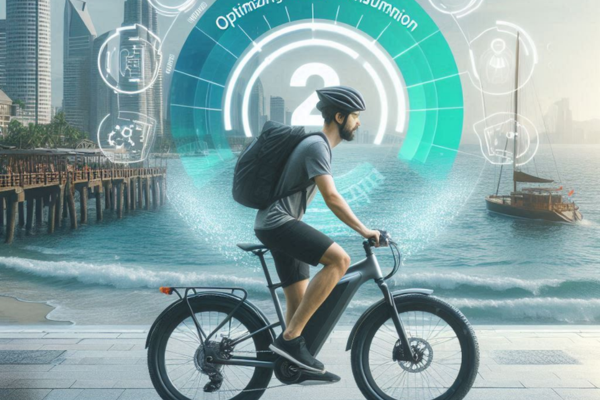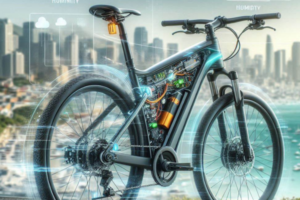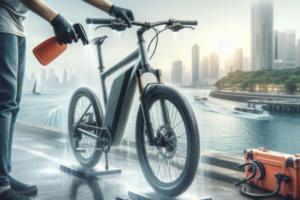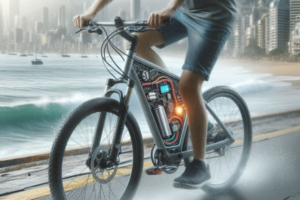How to Optimize the Energy Consumption of Your Electric Bicycle in Humid Climates
🔋 Why Humidity Affects Energy Efficiency
In humid climates, electric bicycle riders face unique challenges that go beyond wet clothing and fogged-up glasses. The combination of moisture, dense air, and fluctuating wind conditions can significantly impact how much energy your e-bike consumes — and how far you can travel on a single charge. Understanding these variables is the first step toward optimizing your ride and extending battery life, especially if you commute daily or ride for long stretches near coastal zones.
Air becomes heavier with increased humidity, which means your electric motor has to work harder to maintain the same speed — particularly when facing headwinds. In addition, the moisture affects tire grip, rolling resistance, and even rider posture, all of which can subtly increase drag and energy consumption over time. While many riders focus on motor power or battery size, the real secret to efficient riding lies in how all parts — including clothing, accessories, and riding habits — respond to the environment.
🌫️ Dry vs. Humid Riding Conditions: What Changes?
Below is a simple comparison of how dry and humid conditions influence your electric bicycle’s performance. This table can help you visualize what to expect, and why thoughtful adjustments are essential in tropical or coastal environments.
| Feature | Dry Climate | Humid Climate |
|---|---|---|
| Air Density | Lower | Higher (more resistance) |
| Rolling Resistance | Moderate | Slightly Increased |
| Battery Range | Optimal | Reduced |
| Traction | Predictable | More slippery surfaces |
| Motor Load | Standard | Increased effort |
As the table shows, energy consumption tends to rise in humid conditions, even if you’re using the same route and settings. Being aware of these differences can help you make smarter decisions — whether that means reducing your average speed, modifying your tire pressure, or adjusting your assistance level (PAS).
📌 Key Insight
Tip: In humid conditions, riding 2–3 km/h slower may increase your battery range by up to 10%, especially if wind resistance is high. Don’t underestimate the value of a smooth, steady pace.
🛠️ Essential Maintenance for Energy Efficiency in Humid Environments
One of the simplest yet most powerful ways to reduce energy consumption is by keeping your e-bike well-maintained — and in humid climates, this becomes even more important. Moisture accelerates corrosion, affects electronic performance, and increases mechanical resistance, all of which drain your battery faster. Even the most advanced motor can’t compensate for poorly inflated tires or a drivetrain clogged with wet debris.
Below is a practical maintenance checklist designed specifically for riders who frequently face humid, rainy, or coastal conditions. Incorporating these actions into your weekly or monthly routine can dramatically improve the efficiency and lifespan of your e-bike.
✅ E-Bike Maintenance Checklist for Humid Climates
- 🔧 Check tire pressure weekly — underinflated tires increase rolling resistance and energy consumption.
- 🧼 Clean and lubricate the chain after rides in wet or muddy conditions to prevent friction and rust.
- 🔋 Inspect battery terminals for signs of corrosion; clean gently with a dry cloth if needed.
- 🛡️ Apply a light protective coating to exposed metal parts to prevent moisture-related damage.
- 🌦️ Store the e-bike indoors or under cover to reduce long-term exposure to humidity and salt in the air.
- ⚙️ Check brake resistance regularly; humidity can affect braking surfaces and lead to energy loss during stops and starts.
- 💡 Inspect electrical connections for moisture buildup, especially around display units and motor wiring.
These small, consistent efforts not only preserve your bike — they also reduce energy consumption by ensuring your system runs smoothly and doesn’t overcompensate for physical inefficiencies. Think of it like stretching before a workout: it doesn’t take much time, but it helps everything work better with less effort.
🧩 Impact of E-Bike Configuration and Mode Settings
Another factor that dramatically affects energy consumption — especially in humid conditions — is how you configure your pedal-assist system (PAS), throttle mode, and speed settings. Many e-bikes allow riders to select between eco, standard, and sport modes. These modes control how much motor assistance you receive per pedal stroke, which directly influences how quickly your battery drains.
In humid weather, where wind resistance is already elevated, choosing the right assistance level becomes essential. Sport mode might feel smoother on hills or when battling crosswinds, but it will drain the battery much faster than eco or standard mode. For flat routes or mild inclines, opting for a lower level of assist — and pedaling just a bit more — can double your range.
If your e-bike has a display that tracks efficiency (e.g., watts per kilometer), pay attention to how your assist level correlates with energy output. Riders who take time to understand this relationship can reduce battery consumption by 15–20%, especially on mixed-terrain or humid rides where maintaining a steady pace is more difficult.
⚙️ Pedaling Strategy and Terrain Awareness
Many riders overlook how much their personal pedaling strategy can influence energy consumption, especially when environmental conditions are more demanding. In humid areas — where heat and moisture already challenge both your body and the motor — maintaining a smooth and consistent cadence can significantly reduce energy spikes.
Instead of accelerating aggressively from a stop or relying on short bursts of throttle, try to adopt a rhythm where your pedaling complements the motor assist. Avoid “over-assisting,” where the motor does all the work while you contribute minimally. This practice drains the battery quickly, especially on routes with frequent stops, like urban traffic or coastal boardwalks.
On humid days, the air feels heavier and movement takes more effort. If your route includes hills, it’s best to anticipate them early and switch to a lower gear before you begin the climb. Let the PAS assist you smoothly rather than forcing a last-minute surge that consumes more power and increases heat buildup in the motor.
🌬️ Case Insight: Real Impact in Coastal Cities
Let’s look at a real-world example. In Barranquilla, Colombia, a young entrepreneur who uses an e-bike to make food deliveries five days a week noticed that his range was inconsistent. On certain routes near the coast, his battery dropped much faster than expected, especially during mid-afternoon rides.
After adjusting a few habits — lowering his average speed from 25 km/h to 22 km/h, maintaining steady pedaling in eco mode, and cleaning his drivetrain every two days — he reported a 15% increase in daily battery range. This meant fewer recharges and more deliveries per trip, directly impacting his income.
This case shows that optimizing energy usage isn’t about doing less — it’s about doing it smarter. A few strategic changes adapted to the climate can yield measurable benefits, even without changing the bike itself.
📊 Visual Comparison: Power Waste vs. Efficiency
To help you visualize how small choices add up over time, here’s a simplified comparison between an inefficient and an optimized riding approach in humid conditions:
- 🔴 Inefficient Riding: High-assist mode + sudden acceleration + dirty drivetrain = 30% faster battery drain
- 🟢 Optimized Riding: Eco mode + steady cadence + clean components = smoother ride, extended range
In essence, the smarter your riding style, the less your motor has to work — and the further you’ll go. Humidity may increase resistance, but your habits have the power to balance that out.
Tip: Try maintaining a cadence of 60–80 RPM. This keeps your effort consistent and allows the PAS system to operate more efficiently — especially in humid air, where sudden bursts of torque are more costly.
🌡️ Battery Care and Storage Tips for Humid Environments
One of the most overlooked aspects of energy efficiency is how you care for your battery — especially in regions with high humidity. Moisture in the air can lead to corrosion, temperature instability, and reduced voltage delivery, all of which affect how efficiently your motor operates and how long your battery lasts per charge.
It’s important to remember that lithium-ion batteries are sensitive to both temperature and moisture. When stored or charged in areas with high humidity, internal condensation may slowly degrade battery cells, leading to lower performance over time. To prevent this, create a routine that protects your battery before, during, and after each ride.
🧰 Battery Care Best Practices for Humid Conditions
- 🌦️ Always dry your battery case after wet rides, even if it’s water-resistant. Wipe it down gently to avoid residue buildup.
- 🏠 Charge and store your battery indoors, in a dry, shaded place with consistent temperature. Avoid leaving it on the bike overnight outside.
- 🔋 Keep the charge between 20% and 80% when not in use. Full charges or complete drains in humid environments accelerate cell wear.
- 🧴 Use dielectric grease (in small amounts) on exposed connectors to prevent corrosion from salt or moisture.
- ⚠️ Avoid sealing your battery in plastic bags, as this may trap moisture rather than repel it.
Many riders believe the battery is simply “plug-and-play,” but small adjustments in care routines can dramatically improve long-term performance. Especially in tropical areas, battery degradation happens faster unless you’re proactively protecting it from environmental exposure.
🧠 Common Myths About E-Bike Energy Use
Let’s clear up a few common misconceptions that lead riders — especially in humid climates — to unknowingly waste energy:
- ❌ “It’s more efficient to ride at top speed.” False. Higher speeds create more air resistance, especially in moist air. Moderate speed equals more range.
- ❌ “Charging the battery right after a ride is best.” Not always. Let it cool down first — charging while the battery is warm can reduce efficiency and increase wear.
- ❌ “Waterproof means worry-free.” Water-resistant components still require post-ride drying and periodic inspection in humid environments.
By debunking these myths and embracing mindful habits, you gain more control over how your e-bike responds to the challenges of your environment. Knowledge is power — and in this case, also range.
Did you know? A battery consistently exposed to humidity without proper care may lose up to 15% of its range after just one year of daily use. Prevention is your most powerful tool.
📚 Frequently Asked Questions (FAQs)
❓ How much energy efficiency can I gain by changing my riding habits?
Riders who adopt smooth acceleration, moderate speeds, and eco-mode usage can typically reduce energy consumption by 10–20% — especially in humid or windy environments. That could mean an extra 5–10 kilometers of range per charge.
❓ Should I avoid riding on extremely humid days?
Not necessarily, but you should adjust your expectations. Battery performance may decrease slightly, so plan shorter routes or ride with a lower assist level. Also, be sure to dry and maintain your bike after each ride.
❓ Is it worth investing in accessories to protect against humidity?
Absolutely. Fenders, sealed connectors, breathable clothing, and anti-corrosion sprays all contribute to long-term energy savings by keeping your bike clean, dry, and efficient — especially if you ride daily in a coastal city.
❓ What tire pressure is best in humid climates?
Always follow the manufacturer’s PSI recommendations, but stay on the higher end of the range to reduce rolling resistance. Check tire pressure weekly, as fluctuations in humidity and temperature can affect air levels.
💬 Final Thoughts
Optimizing your electric bicycle’s energy consumption in humid climates is not about spending more — it’s about riding smarter. From routine maintenance to better understanding your pedal-assist settings and battery behavior, every small decision adds up to more range, more reliability, and a more rewarding experience.
Whether you’re riding along a tropical shoreline, navigating a rainy urban commute, or simply want your battery to last longer — the tools are in your hands. With awareness, care, and consistency, your e-bike becomes not just transportation, but a beautifully efficient extension of your lifestyle.
Have you ever adjusted your riding style because of humidity? Share your favorite tips, challenges, or success stories in the comments — your experience might help another rider go further, safer, and smarter.



